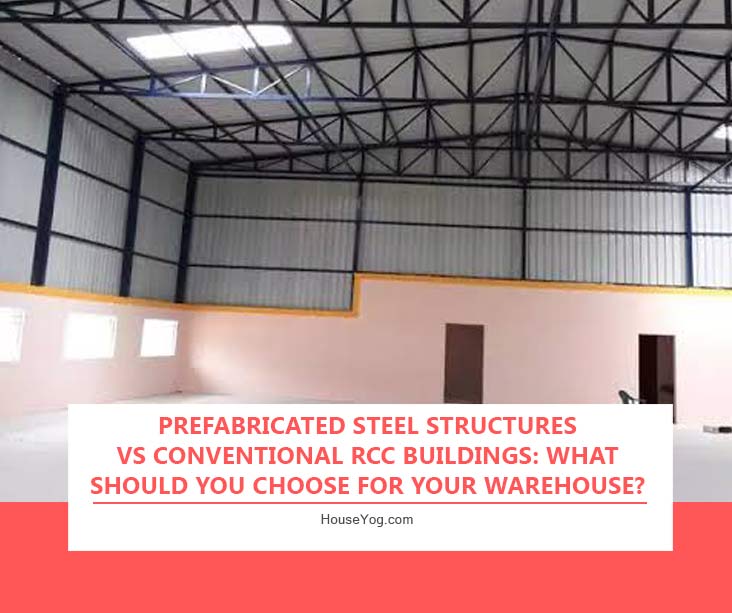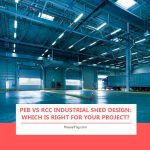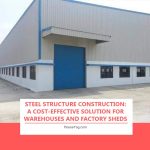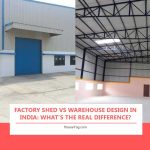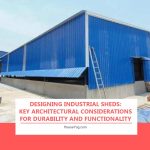Making the Right Choice for Your Warehouse and industrial Facility
When it comes to constructing a warehouse, one of the first big decisions you’ll need to make is the choice of structural system:
Should you go for a prefabricated steel structure (PEB) or a conventional RCC (Reinforced Cement Concrete) building?
Each method comes with its own strengths, costs, and timelines. Choosing the wrong one can impact your project budget, future expansion potential, and operational efficiency.
In this post, we’ll explore a detailed comparison of prefabricated steel structures vs RCC buildings—so you can decide which approach best suits your warehouse or industrial shed project.
1. What Is a Prefabricated Steel Structure?
A prefabricated steel structure (commonly called a PEB or Pre-Engineered Building) is a factory-made steel building, designed in advance and assembled on-site using bolted connections. It typically consists of:
- Steel columns and rafters
- Roof and wall cladding sheets (like Tata or Jindal)
- Insulation, ventilation, and skylight provisions
2. What Is a Conventional RCC Building?
An RCC (Reinforced Cement Concrete) building uses steel reinforcement bars embedded in concrete, typically built brick by brick or column by column on-site. This traditional method is often used for residential or office buildings but is also seen in warehouse construction.
3. Prefabricated Steel vs RCC: A Head-to-Head Comparison
Here’s how both systems compare across critical factors:
| Factor | Prefabricated Steel Structure | RCC Building |
| Speed of Construction | Much faster (40–60% time saving) | Slower, due to curing time and sequential work |
| Initial Cost | Slightly lower or similar depending on design | Higher material and labor costs |
| Foundation Requirements | Light foundation (less concrete & steel) | Heavy foundation required |
| Customization & Expansion | High flexibility; easy to expand later | Expansion is difficult and costly |
| Material Waste | Minimal, due to factory precision | Higher on-site material wastage |
| Weather Resistance | Excellent when designed properly | Strong but vulnerable to seepage if not waterproofed |
| Lifespan & Durability | 30+ years with proper maintenance | 50+ years with heavy-duty upkeep |
| Thermal Insulation | Requires additional layers (PUF, Rockwool, etc.) | RCC provides basic insulation naturally |
| Aesthetic Flexibility | Good for industrial; limited for creative facades | Offers better finish for offices/residential units |
| Environmental Impact | Green option; recyclable steel | High carbon footprint due to cement production |
4. When to Choose Prefabricated Steel Structures
Steel frame sheds and PEBs are ideal for warehouses and factory sheds when:
- You need fast construction (within 2–3 months)
- The structure is large and open-span (no internal columns)
- Future expansion or relocation is expected
- You’re looking to reduce long-term maintenance costs
- You prefer clean construction sites with minimal debris
Industries commonly using steel structures:
- E-commerce & logistics
- Agro-warehousing
- Cold storage facilities
- Manufacturing sheds
- Garment factories
5. When to Consider RCC Buildings
While RCC may not be the fastest method, it is a good choice when:
- Multistorey construction is required (G+1 or more)
- The building will include heavy machine foundations
- The structure needs to withstand harsh environments over decades
- You want permanent, office-type structures alongside warehouses
6. Cost Comparison: Steel vs RCC for Warehouses
Although costs vary by location and design, here’s a general estimate for Bihar and Jharkhand:
| Structure Type | Approx. Cost per Sq. Ft. |
| Prefabricated Steel Shed on empty space | ₹700 – ₹1,200 |
| RCC Warehouse Building from foundation | ₹1100 – ₹1600 |
👉 Note: These costs can vary based on site preparation, foundation, land filling, roofing, insulation, ventilation, crane usage, and site accessibility.
7. Maintenance and Lifecycle Considerations
- Steel sheds require anti-rust coating and painting every few years but are easier to repair and upgrade.
- RCC buildings may suffer from cracks, seepage, and plaster damage over time, leading to costly repairs.
8. Final Thoughts: Which One Should You Choose?
If you’re building a warehouse or industrial facility in Bihar or Jharkhand, here’s a simple way to decide:
| Choose Prefabricated Steel | Choose RCC Building |
| Faster construction | Long-term occupancy |
| Open-span, large spaces | Multi-storey or hybrid structures |
| Flexibility & future growth | Permanence & load-bearing needs |
| Cost-effective maintenance | More insulation with less add-ons |
Need Help Choosing the Right Construction Method?
At Houseyog, we design and build both prefabricated steel sheds and RCC warehouses, tailored to your needs. Our team of architects and engineers helps you:
- Compare structure types with real cost estimates
- Get structural drawings and 3D models
- Plan warehouse layout, ventilation, and logistics zones
- Execute high-quality construction across Bihar and Jharkhand
Call us at +91 751800 58808 to get a custom quote or schedule a free consultation.
Frequently Asked Questions (FAQs)
In most cases, prefabricated steel structures are more cost-effective due to faster construction, less labor, and lower foundation costs. RCC buildings tend to have higher upfront and labor-related costs.
Yes. When properly designed with anti-rust coatings and weather protection, prefabricated steel buildings can last 30–40 years even in hot, humid, or rainy climates common in India.
Absolutely. One of the biggest advantages of steel structures is easy future expansion or modification without major structural changes.
No. Prefabricated steel buildings are lightweight and require simpler, shallow foundations compared to the heavy RCC load-bearing foundations.
A medium-sized steel warehouse (10,000 sq. ft.) can be completed in 2–3 months. The same project with RCC might take 6–9 months or longer due to curing, brickwork, and plastering.
Yes. Steel buildings can be fitted with PUF panels, rockwool, or glasswool insulation to maintain interior temperature, especially useful for cold storage or food-grade warehouses.
Both can be made safe for seismic zones, but steel structures offer better flexibility, which helps absorb seismic shocks more effectively than rigid RCC frames.
It’s technically possible, but RCC is generally preferred for multi-storey structures due to higher thermal mass and design traditions. Steel structures are best suited for single-level industrial use.
